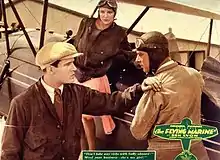| The Flying Marine | |
|---|---|
 | |
| Directed by | Albert S. Rogell |
| Written by |
|
| Produced by | Harry Cohn |
| Starring | |
| Cinematography | |
| Edited by | William Hamilton |
Production company | |
| Distributed by | Columbia Pictures |
Release date |
|
Running time | 65 minutes |
| Country | United States |
| Languages | Sound (Part-Talkie) English Intertitles |
The Flying Marine is a 1929 American sound part-talkie action film directed by Albert S. Rogell and starring Ben Lyon, Shirley Mason and Jason Robards Sr.[1] In addition to sequences with audible dialogue or talking sequences, the film features a synchronized musical score and sound effects along with English intertitles. The soundtrack was recorded using the Western Electric sound-on-film system. [2] [N 1]
The film centers around a tale of brothers romancing the same girl.
Plot
Mitch Moran (Jason Robards Sr.), a commercial pilot, takes his young brother, Steve (Ben Lyon) under his wing. Steve, a military aviator, has just been discharged from the Marines.
Both brothers fall in love with Sally (Shirley Mason), who is first attracted to the more dashing image of Steve but she soon discovers he is irresponsible and that it is actually Mitch she loves.
About to break her engagement, Sally receives word that Steve has been injured in an accident resulting from stunt work for a film. She and Mitch agree their relationship must be kept secret from Steve. The younger brother who had lost his hearing as a result of the injury, finds out that Mitch and Sally raised the money for an operation he needs.
Steve regains his hearing and goes back to stunt flying but to save his brother from a midair disaster, he sacrifices his own life.
Cast
- Ben Lyon as Steve Moran
- Shirley Mason as Sally
- Jason Robards Sr. as Mitch Moran
Production
Aviation film historian Stephen Pendo, in Aviation in the Cinema (1985) characterized The Flying Marine as a typical early "talkie" with a heavy reliance on dialogue, with as much as 70 percent of the film taken up by conversations.[4]
Reception
Aviation film historian James M. Farmer in Celluloid Wings: The Impact of Movies on Aviation (1984), had a similar reaction, saying that The Flying Marine was "... long on talk. Short on air action, save the concluding sequence and earlier air crash."[5]
In a modern review in the TV Guide, The Flying Marine rated only one star out of five. The review stated: "Only the capable performances by the cast and some nifty airplane sequences keep this tepid tale of brothers romancing the same girl from being a total bore. ...Could have been better had more effort been applied to action sequences instead of the dull dramatics."[6]
See also
References
Notes
Citations
Bibliography
- Farmer, James H. Celluloid Wings: The Impact of Movies on Aviation (1st ed.). Blue Ridge Summit, Pennsylvania: TAB Books 1984. ISBN 978-0-83062-374-7.
- Munden, Kenneth White. The American Film Institute Catalog of Motion Pictures Produced in the United States, Part 1. Berkeley, California: University of California Press, 1997. ISBN 978-0-52020-970-1.
- Paris, Michael. From the Wright Brothers to Top gun: Aviation, Nationalism, and Popular Cinema. Manchester, UK: Manchester University Press, 1995. ISBN 978-0-7190-4074-0.
- Pendo, Stephen. Aviation in the Cinema. Lanham, Maryland: Scarecrow Press, 1985. ISBN 0-8-1081-746-2.
- Wynne, H. Hugh. The Motion Picture Stunt Pilots and Hollywood's Classic Aviation Movies. Missoula, Montana: Pictorial Histories Publishing Co., 1987. ISBN 978-0-93312-685-5.